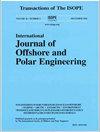CFD Simulations of Two Wind Turbines Operating in Line
IF 0.6
4区 工程技术
Q4 ENGINEERING, CIVIL
International Journal of Offshore and Polar Engineering
Pub Date : 2023-09-01
DOI:10.17736/ijope.2023.jc908
引用次数: 1
Abstract
Generally, the wake behind a wind turbine is characterized as a reduction in wind velocity and an increase in turbulence level compared to the free stream condition. In wind farms where wind turbines are grouped in arrays, under unfavorable conditions, downstream wind turbines will operate in the wakes of upstream turbines, and thus will harm the overall efficiency of wind farms. Accurately predicting the performance of downstream turbines and the interactions between multiple turbine wakes are crucial to the design of more efficient wind farms because it forms the cornerstone of wind farm layout optimization algorithms. In the present study, we perform CFD simulations for the NTNU Blind Test 2 experiment in which two turbines were placed in a closed-loop wind tunnel and operating in line. The Reynolds-Averaged Navier Stokes (RANS) equations with the k-ω SST turbulence model are adopted in the simulations. For each of the two wind turbines, geometries including the blades, hub, nacelle, and tower are fully resolved. The Moving-Grid-Formulation (MVG) approach with a sliding interface technique is leveraged to handle the relative motion between the rotating and stationary portions of the wind turbines. In the simulations, the values of tip-speed ratio (TSR) for the upstream and downstream turbines are 4 and 6, respectively. The CFD-predicted thrust and power coefficients are obtained under an inlet velocity of 10 m/s and are compared against the experiment results. In addition, the wake structures of the two wind turbines are also visualized and discussed.双风机在线运行的CFD模拟
本文章由计算机程序翻译,如有差异,请以英文原文为准。
求助全文
约1分钟内获得全文
求助全文
来源期刊

International Journal of Offshore and Polar Engineering
ENGINEERING, CIVIL-ENGINEERING, OCEAN
CiteScore
2.00
自引率
0.00%
发文量
44
审稿时长
>12 weeks
期刊介绍:
The primary aim of the IJOPE is to serve engineers and researchers worldwide by disseminating technical information of permanent interest in the fields of offshore, ocean, polar energy/resources and materials engineering. The IJOPE is the principal periodical of The International Society of Offshore and Polar Engineers (ISOPE), which is very active in the dissemination of technical information and organization of symposia and conferences in these fields throughout the world.
Theoretical, experimental and engineering research papers are welcome. Brief reports of research results or outstanding engineering achievements of likely interest to readers will be published in the Technical Notes format.
 求助内容:
求助内容: 应助结果提醒方式:
应助结果提醒方式:


